The Crutchfield story
Chapter 1: The early years (1974-1979)
Only a handful of companies have remained in business for 50 years. An even smaller number remain under the same ownership for this length of time. And a tiny, tiny subset remains under the same ownership and management for 50 years. That makes Crutchfield an exceedingly rare company.
There has been much interest about how Crutchfield has achieved this unique accomplishment. Therefore, as part of our 50th anniversary celebration, I want to tell you our story in my own words.
Entrepreneurial spirit
An entrepreneur’s passion is at the heart of every successful business, and that passion typically begins in their youth. Therefore, you may be interested in learning how my passion for consumer electronics was cultivated starting in childhood.
I was born in 1942 in Charlottesville, Virginia. My father was a physician at the University of Virginia Health System. He was an early adopter of technology. When I was around seven years old, I remember him replacing the 78 rpm record playing mechanism in our Capehart with a newly introduced 33 rpm mechanism. Capehart was a leading manufacturer of large console AM radio/record player systems. Commercial FM radio stations were just beginning to appear, and we did not have one in Charlottesville at that time.
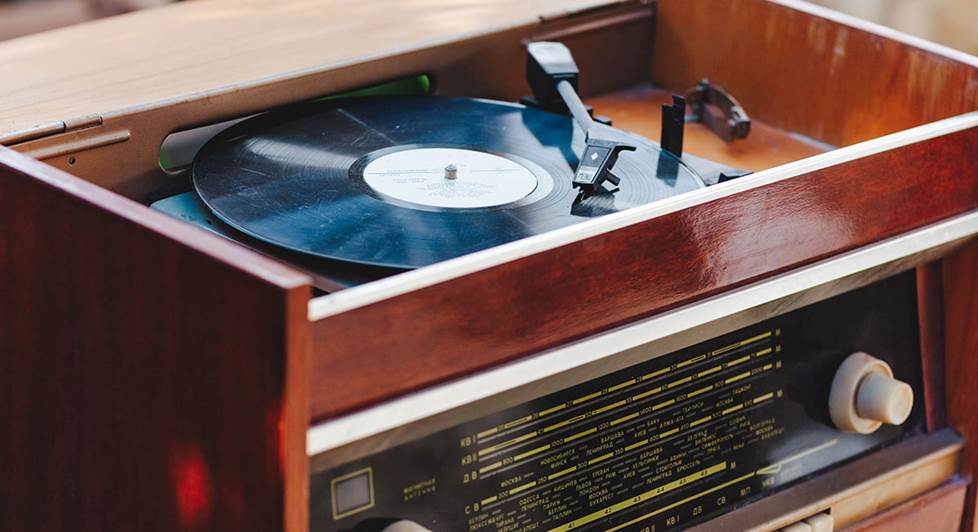
This vintage turntable and its wooden cabinet were typical of the era.
78 rpm records were introduced in 1912 and remained the industry standard for almost 40 years. They had extremely poor fidelity and could only play for five minutes. The new 33 rpm records had far better fidelity and could play for up to 20 minutes. This technology ushered in true high fidelity. However, it was monophonic audio (single channel) until stereo records were introduced approximately ten years later.
In 1948 my father bought the first television receiver in our area. Although it had an exceptionally large and heavy cabinet, the picture tube’s screen (CRT) was very small. To produce a larger picture, the TV came with a magnifying glass mounted on a tripod. As I recall, we placed it approximately three feet in front of the tiny screen. It magnified the image to twice that of the picture tube’s screen. Even with that level of magnification, it was an exceedingly small picture compared to what we enjoy today. And the images were in black and white.
Although the video quality was terrible by today’s standards, people flocked to our home to see this new breakthrough technology. The thought of video images being transmitted over radio waves was amazing.
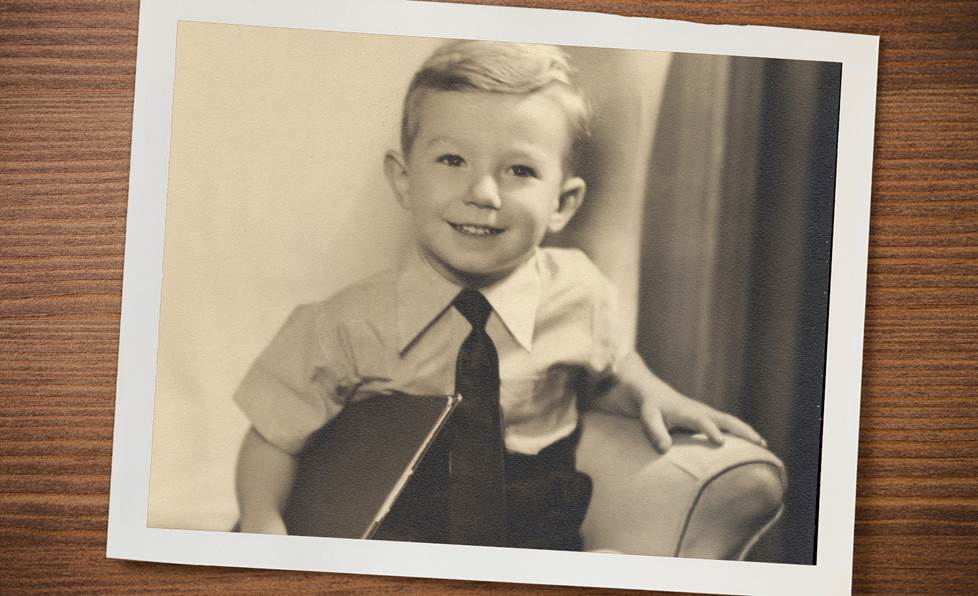
Young Bill Crutchfield, ready for his first sale (1946).
Experiencing the true dawn of high-fidelity record players and televisions was the spark that ignited my lifelong passion for consumer electronics. In 1950, when I was eight, I built a radio using the recently invented transistor. Like the early televisions, this technology was amazing. The single transistor which I used in my radio was slightly larger than a pencil’s eraser. It replaced a much larger vacuum tube.
Transistors represented a huge breakthrough in electronics. However, no one at the time could have guessed how far solid-state technology would evolve. By comparison, an Apple iPhone® 15 Pro has 19 billion transistors. Again, my radio only had one.
When I was 13, I built what, as far as I know, was the first stereo system in Virginia. It was very crude by today’s standards. I combined two sets of speakers connected to two separate mono hi-fi amplifiers in my bedroom. They were connected to a two-channel tape head mounted to an old office reel-to-reel tape recorder.
Since this was before stereo records and FM stereo broadcasts, the only available content was from a handful of prerecorded tapes. One was a demo tape which provided soundtracks of trains and airplanes going from left to right across my bedroom. People were as amazed by my demonstrations of stereophonic sound as they were by my father’s demonstration of an early television set.
My first business venture
Stereo technology evolved rapidly over the next two years. Stereo records were becoming available, and FM stereo broadcasting was on the horizon. Obviously, the demand was picking up for this new technology. However, few people in our area knew how to install it. So, when I was 15, I formed a tiny, one-person business of installing newly available stereo equipment in homes throughout the greater Charlottesville community. I ran that little business throughout my time in high school and college.
After graduating from the University of Virginia, my business venture days ended due to the greatest geo-political event of that time, the war in Vietnam. Instead of waiting to be drafted, I joined the U.S. Air Force officer training program. I eventually commanded a Titan II intercontinental ballistic missile crew and held the rank of Captain.
After the Air Force, I held a couple of middle management jobs back in Charlottesville. At my last one, I was the vice president and general manager of a multi-location materials handling company. We primarily sold and serviced forklift trucks.
My mail order startup
Yearning to run my own business again, I started restoring old 356 Porsches as a sideline venture. I thought these cars would be more marketable if I installed modern (for that time) car stereos in them. Since no local store knew anything about these new aftermarket products, I looked in various automotive and audio magazines to discover the mail order retailers of car stereos. Finding that none existed, I started Crutchfield in March 1974 with the objective of being the first car stereo mail order retailer.
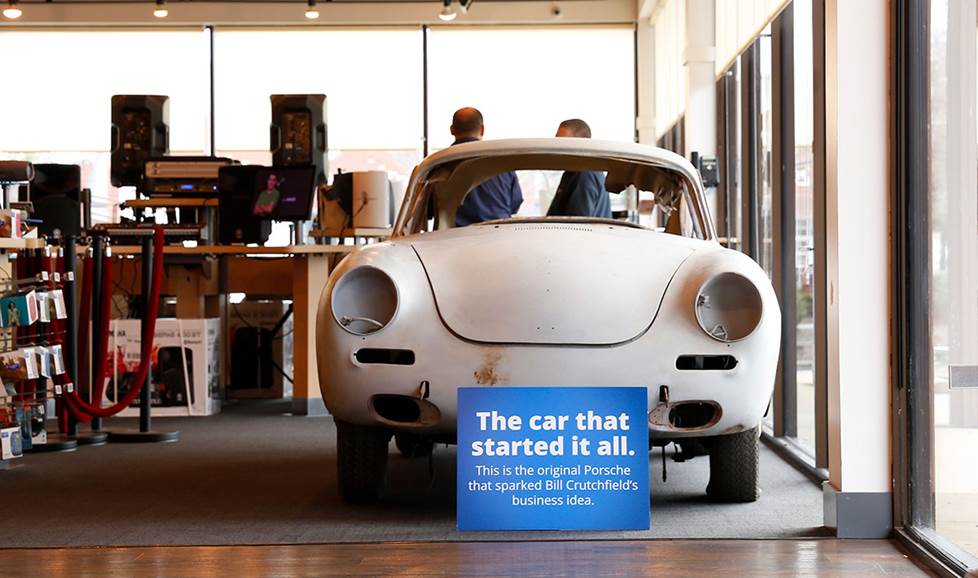
The original Porsche is now parked on our showroom floor of our Charlottesville, VA retail store.
I picked the name Crutchfield since it was my family name. I believed then and believe now that companies named for their founders enjoy more longevity than companies with generic names. That may be because founders and their family successors avoid doing anything that would tarnish their family name. Had I named the company something like "Bill’s Car Stereo," I may not have had such a strong incentive to succeed.
To say that I was uncapitalized would be an understatement. I started with an initial capitalization of only $1,000 and an old Porsche in the process of restoration. In the early 1970s there were few early-stage investment firms with any interest in small business startups. So, I did what most entrepreneurs had to do in those days. I went to a bank to seek a loan.
Fortunately, I knew a bank president who owned an old Porsche. After pitching my idea of becoming the first car stereo mail order business, he agreed to provide me with a $25,000 line of credit. He based his decision on knowing that I was a person of good character and had always demonstrated a strong work ethic.
Bank lending standards in 1974 were much lower than they are today. The 2008 Financial Crisis changed that. No bank today could extend a loan based on a banker’s subjective evaluations primarily founded on a person's character and work ethic.
Acquiring vendor partners
The next problem was convincing the manufacturers of these new car stereo products to allow me to become an authorized retailer. Although products then and now can be acquired through "backdoor" channels, I never believed this was an ethical business practice. So, I tenaciously pursued them to authorize me.
The manufacturers’ major point of concern was the erroneous belief that car stereo products should only be sold by local store retailers that had on-site installation facilities. I countered by stressing that many communities like mine did not have this type of specialty retailer. This void could be filled by a mail order retailer like what I was proposing. That argument worked. Finally, I received their blessings and became the first authorized mail order retailer of quality car stereo products.
Year one: Building my company on a financial shoestring
With a bank line of credit and dealer authorizations, I started to build my company on a financial shoestring. The first purchase I made was a used IBM Executive typewriter. It was unique since that model could type letters and numbers proportionally as modern word processing programs do. Therefore, my copy would look like it was typeset by a printer as opposed to being produced on a typewriter.
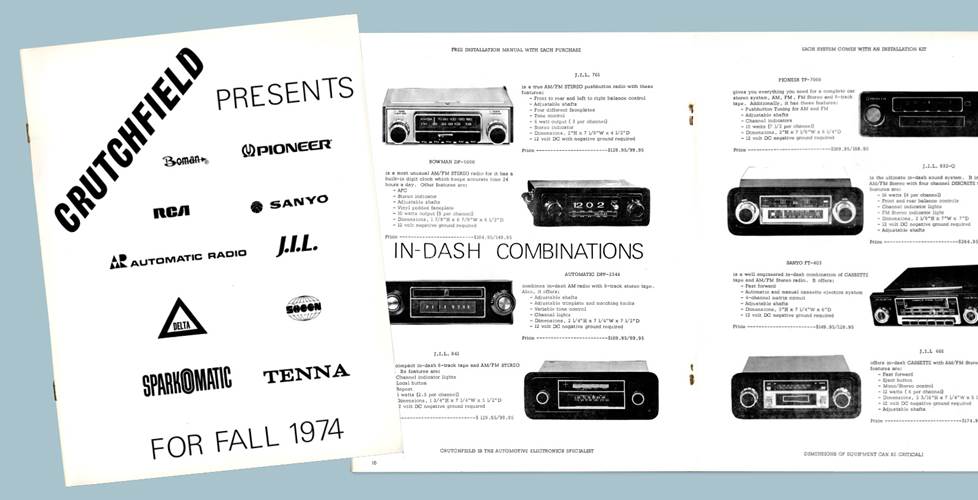
The first Crutchfield catalog was typical of its day (1974).
Like most catalogs of that era, my copy was very basic. I just mentioned the specifications and features of the products in short, bullet copy. Along with my crude copy, I submitted generic product images provided by the manufacturers to a local offset printer.
With my line of bank credit, I was able to order merchandise, print 10,000 copies of my first catalog, and submit some small ads to the popular automobile and audio magazines. My ads’ headlines were "Free Car Stereo Catalog." I set up a packing bench and stock area in my mother’s basement. My father had died two years earlier. My office consisted of a phone, adding machine, and typewriter on the desk in my bedroom.
A brush with bankruptcy
By August of 1974, catalog requests started to come in and I started to mail the catalog. In September, my first order came in. A few more trickled in throughout the month. To my great disappointment, September sales were only $416. October was not much better with sales of only $1,369.
Having pulled down $20,000 of my $25,000 line of credit, the bank froze my line. They felt that it was the worst loan in the bank’s state-wide system. They were convinced that I was headed straight for Chapter 7 bankruptcy, which bypasses reorganization and takes a company directly to liquidation. Furthermore, I was having trouble paying the manufacturers for my merchandise and the magazines for my advertising. My little company was in serious trouble.
Because my name was on the company, I did not want to tarnish it with bankruptcy. I strongly believed that I had identified a viable and needed niche in the market. Therefore, I rationalized that the problem had to be with my catalog. Was it pricing, product selection, the look of the catalog, or my service? If not, what was it?
Turning to my customers for valuable insight
I did not have the money for a consultant, and even if I had, a consultant probably would not have found the solution. I have found that consultants are excellent at understanding best-in-class current business practices. But they are not good at innovating totally unique, often unconventional approaches to solving problems faced by business startups.
I needed input, so I reached out to the people who might know best. They were my customers and those catalog subscribers who were not yet customers. I wrote simple, one-page questionnaires for each of these two groups.
What came back was eye-opening. Overwhelmingly, they did not understand how to buy and install car stereos.
Back then, vehicles did not have precut holes for speakers in their doors, kick panels or rear decks. Owners had to cut steel to accommodate speakers. Installers had to run speaker wire from the head units to the various speaker locations. In some cases, vehicles did not have radio antennas. This meant that people had to drill holes in fenders to install them.
All of this was very intimidating for the average do-it-yourselfer. This feedback explained why people were afraid to buy and self-install my products.
Crutchfield becomes an information company
The understanding I gained from my customers' feedback led me to the "eureka" moment that would transform my business into what it is today. I decided to shift gears and reinvent my company from following a traditional mail order retail business model to being an "information company" which happened to sell aftermarket car stereo products.
This change of focus led me to invent what might have been the world’s first magalog. It was a hybrid between a magazine filled with informational content and a catalog filled with products described with much richer, more content-centric copy than what was used at that time in catalogs. My content explained how to buy and install car stereo products.
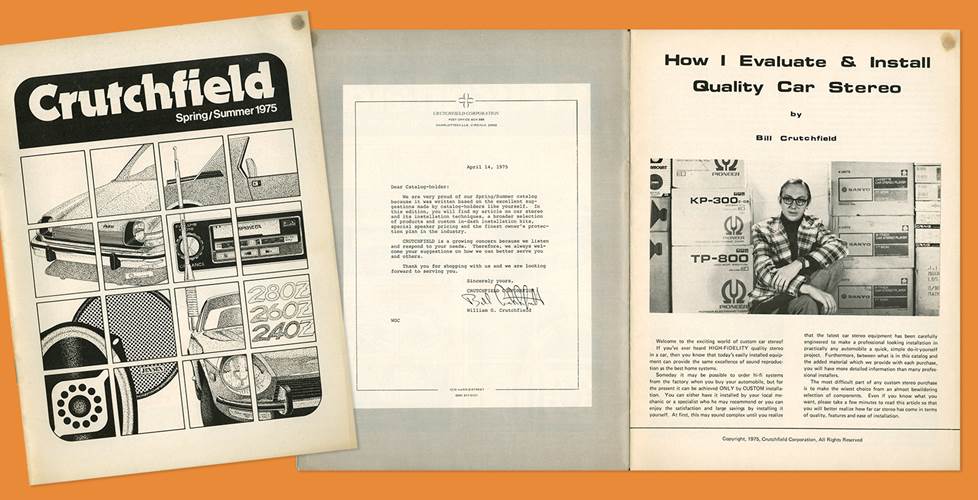
The second Crutchfield catalog included shopping advice and installation tips (1975).
Also, I added accessories which would make installations easier and more professional looking. Rather than relying on my manufacturers’ random stock photos, I photographed the products myself in a consistent format. One of my other childhood hobbies was photography. During my first two years at the University of Virginia, I was the photography editor of the school’s newspaper.
Another innovation of my information company was telephone technical support. I even had an off-premises telephone extension in my bedroom in order that I could answer customer questions at all hours. In addition, I provided printed material offered by third parties. I gave away a booklet on car stereo provided by Pioneer and vehicle-specific installation instructions provided by Chilton’s.
Year two: The beginning of success
My revolutionary magalog mailed in April 1975. Although it was not in full color, the graphics were greatly enhanced. A customer in Connecticut designed a very attractive cover in exchange for a car stereo. Now that Crutchfield was an information company, sales grew dramatically. My one-man, part-time business was breaking even financially, and the bankers were no longer anticipating my imminent bankruptcy. It became time to quit my full-time job and move my business out of my mother’s basement and my bedroom.
A culture of extreme frugality
One benefit of starting a business on a financial shoestring is that it inculcates a culture of extreme frugality. This was further exacerbated by starting a business during the 1970s. That was a period of stagflation. The economy was stagnating, and inflation was soaring. If one could get a loan, interest rates were very high. There was no source of easy financing. This meant that every penny an emerging company earned had to be wisely spent. Also, it meant that I had to prioritize my spending on complying with my financial obligations.
Even in the darkest days, I issued refunds to my customers when their returns arrived. Also, except for the first few months in business, I have always paid my creditors on time. Over the past 50 years, we have earned one of the best credit ratings in our industry.
Quitting my respectable job was risky for I now had no reliable source of income. My business was too weak to provide me with a salary. Although I needed to move my business out of my mother’s home, renting a traditional office/warehouse space was unaffordable.

This photo was taken in my first real office which I built for myself (1976).
Fortunately, I knew of a building which had burned. The front 2,700 square feet was water damaged but usable. I approached the owner with a deal. I would clean up the usable front portion of the building in return for nominal rent. He agreed. I then had to juggle my work between running my small mail order business alone while renovating this building.
Performing so many jobs, I became accustomed to working 100 or more hours nearly every week for several years. Today, I have reduced it to 60 hours.
Growth and evolution
In the summer of 1975, I hired a University of Virginia student as my first employee other than myself. After she returned to school in the late summer, I hired two full-time employees. One of them is Joel Briggs who is still working for us today.
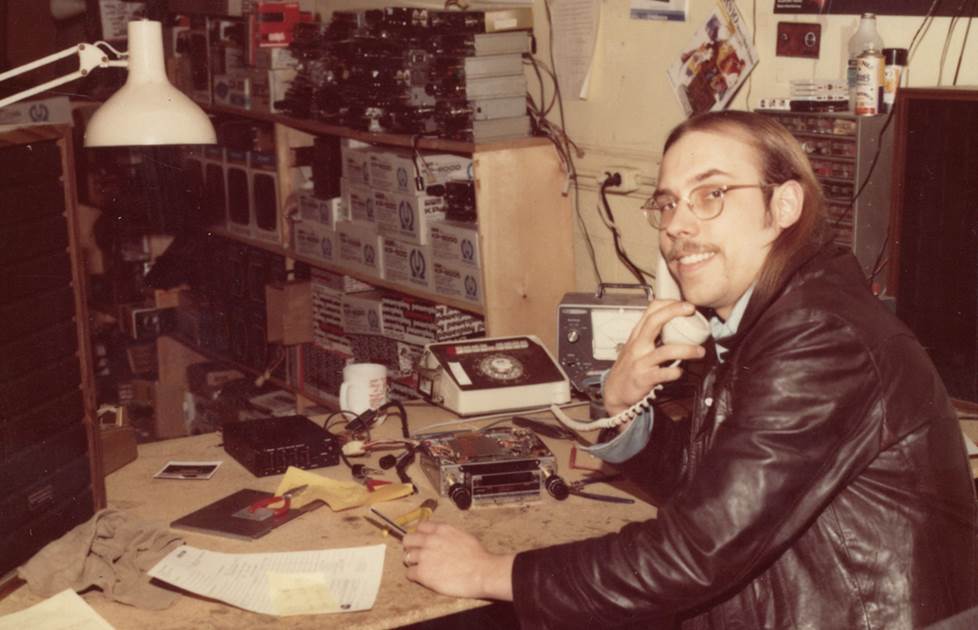
Joel was one of Crutchfield's first two employees – and he continues to support us and our customers (1976).
Over the next two years, we improved our catalogs and services. Our fall 1975 catalog was the first to have a color cover and two-color body pages. In early 1977, we offered toll-free sales lines which only a few mail order retailers offered at that time. Later that year, we added toll-free customer service lines. And in 1979, we added toll-free technical support lines. We may have been the first mail order retailer to offer toll-free customer service and technical support.
Our finances improved sufficiently enough by late 1975 that I was able to pay myself a salary of $500 a month. Even in today’s dollars, that meager salary would be below the poverty level. It was several years before I gave myself a raise. It was a small one. Again, frugality was and still is part of our company’s culture.
The mailing list also grew rapidly as I expanded our magazine advertising. However, I had no automated way to record the names and addresses of my growing mailing list. As a result, I personally typed the first 10,000 names and addresses of our catalog inquirers using sheets of four-layer mailing labels. Having carbon paper between the layers meant that I produced an original and three copies of every label as I typed.
When catalogs were returned from the printer, I would manually affix the labels to the catalogs by wetting them with my tongue or a sponge. When remailing newly published catalogs to previous inquirers, I affixed the carbon copies of the original labels. Obviously, this was not a sustainable operation as the mailing list grew. However, as luck would have it, there was a solution.
Employing technology to sustain our expanding customer base
In 1976, I learned of a local accounting firm that had installed an IBM System/3. The firm used this computer system to provide automated payroll and tax services for its clients. The operation was headed by a very bright, young CPA, Rich Stavitski. I approached him about automating our mailing list function. Fortunately, he and his firm agreed. I then leased an NCR keypunch machine and hired a keypunch operator.
We then started the slow process of converting the 10,000 labels which I had typed along with entering the new catalog inquires to keypunch cards. Every few days, I would take the keypunched cards to Rich’s data center. His computer would print out the labels of the new catalog inquirers. It would also digitally store both the new names and the older names taken from copies of my typed mailing labels.
As the business grew, the number of catalogs which we printed also grew. I learned of a magazine printer in a nearby town. I paid a visit to the owner/president. Being a fellow entrepreneur and airplane pilot, we formed a great partnership which lasted many years. His company had the capability to use Rich’s electronically formatted mailing lists to print names and addresses onto the catalogs during the printing process.
I mentioned that the owner/president of this printer was a fellow pilot. I earned my pilot’s license while in college using some of the proceeds from my home stereo installation business. Obviously, during the early days of my business, I did not have the financial resources to pursue it. Later I was able to buy an inexpensive two-seat airplane and was able to renew this passion. I am still an active pilot today and fly a much more complex airplane.
It was not long before I had to lease another keypunch machine and hire additional keypunch operators. In October 1977, I leased an IBM System/32 computer. In conjunction with a consulting firm in Richmond, Virginia, we developed proprietary invoicing, inventory control, order processing and mailing list programs.
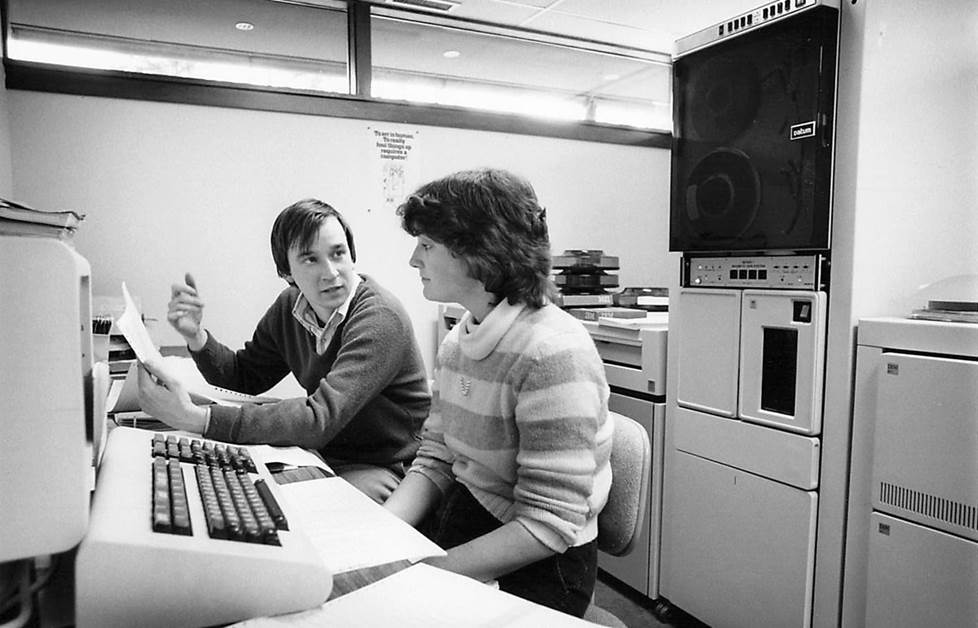
Incorporating technology into our workflow as Crutchfield's customer base continued to grow (1979).
As our data processing and financial management needs grew, I tenaciously recruited Rich to come to work for us. In 1978, he left his accounting firm and became Crutchfield’s first Vice President. Fortunately, he is still with us today.
Here is another example of our rapidly evolving technology. The IBM System/32 computer which we rented in 1977 had a large magnetic disk (As I remember, it was around 30” in diameter). We were amazed that it could store up to 3 MB of data. To put that in perspective, today there are microSD cards (the type used in cameras) which can hold 1.5 GB of data. Those tiny cards have 512 times the storage capacity of that large 1977 IBM hard drive.
A short-lived but impactful magazine for car stereo enthusiasts
In 1978 my entrepreneurial instincts came alive again. At the time, there were several highly regarded national magazines which appealed to home audio enthusiasts. However, there was not a national magazine which appealed to car stereo enthusiasts. Therefore, I decided to create and publish Car Stereo magazine.
I hired an editor, an experienced art director, and a copywriter. Also, we invested in an expensive typesetting machine made by Compugraphic Corporation. Then, I approached our manufacturers about buying display advertising.
The inaugural January 1979 edition was a literary success. However, the magazine was a financial disaster. I found it to be a somewhat impractical situation for us to be buying products from our manufacturers and, at the same time, selling advertising to them. It greatly complicated our relationships. Also, I painfully learned that gaining subscribers was a money-losing proposition. Initial subscriptions were typically solicited at big losses. Publishers banked on renewals being gained at much higher, more sustainable rates. It often takes years for these subscriptions to be profitable.
It was an easy decision to shut down this project. Since I am averse to laying good people off (Crutchfield has not had an employee layoff in our 50-year history), I moved these employees and the Compugraphic machine into our mail order business. The result was a huge enhancement in the professionalism of our catalogs. That move surely improved our sales and more than offset the losses we incurred on Car Stereo magazine. It proves my longstanding belief that doing good things for people pays off in the long run.
A new, energy-efficient building
The business continued to grow during the 1970s. With more employees and larger inventories of our expanded line of products, my 2,700-square-foot facility was becoming too small. It was obvious that I needed a facility much larger. With the business now profitable, I was able to buy an 8-1/4-acre parcel of raw land near the Charlottesville airport in 1976. Now I needed to design and build a facility that would accommodate our unique business.
Besides stagflation, the decade of the 1970s was known as a wake-up call about our country’s dependency on cheap energy. In October 1973, a few months before I started my business, OPEC imposed its first oil embargo on the United States and other Western countries.
Overnight, a barrel of crude oil quadrupled in price. Gas prices at the pump went up dramatically. Also, with supplies of crude oil severely restricted, the availability of gasoline and distillates (heating oil, diesel fuel, kerosene, and jet fuel) was greatly reduced. We would often have to wait in long lines to buy gasoline. Furthermore, we had to reduce the thermostats in our homes, schools, and commercial buildings to save energy.
Although the cost of energy remained high, the supply situation improved over time. But serious energy conservation became a real concern for the first time in our country’s history. It was very much in my mind when I worked with an architect to design a highly energy-efficient, 10,000-square-foot building.
The first floor is mostly underground, and the second floor is basically surrounded by a dirt berm. As a result, approximately 80% of the building is facing dirt which serves as a good insulator from outside temperature variations. We also incorporated the most energy-efficient heat pumps, insulation, and glass. In January 1979, we moved into what was one of the first truly energy-conscious buildings in Virginia.

The entrance to Crutchfield's new HQ, still our home base today (1979).
Due to my sense of frugality, I assumed the role of general contractor for this building. By negotiating directly with and then managing each of our subcontractors, I was able to keep the cost of this building down. Also, I was able to ensure that critical deadlines were met. I have continued to follow this practice as we have built and renovated many buildings over the years. It has saved us a small fortune.
Empowering my customers to make informed shopping decisions
In 1979, I tackled a very serious problem which was creating a bad shopping experience for our car stereo customers.
Some manufacturers were grossly exaggerating the performance of their products by inflating their specifications. For example, many of our car stereo head units were using the same output transistor (amplifier). One manufacturer would rate its power output at 4 watts RMS while others would rate the output from the same chip as being much higher. The same type of misrepresentation pertained to other specifications like distortion, wow and flutter, and FM sensitivity.
The problem became so acute that, in our Fall 1979 catalog, I made the statement that “car stereo specifications are virtually unusable by the average consumer in making product comparisons.”
To address this problem, I consulted with some of our manufacturers’ engineers and the technical editor from a leading audio magazine. We established the “Crutchfield Standard” as being a uniform standard for reporting car stereo specifications. Then, we built a lab equipped with highly professional equipment made by companies like Hewlett Packard, and hired a technician who measured every product which we sold.
From that time on, we only published in our catalogs uniform, accurate measurements. Soon the industry established standards which were very similar to our “Crutchfield Standard.” The era of our shoppers comparing “apples to oranges” was over.
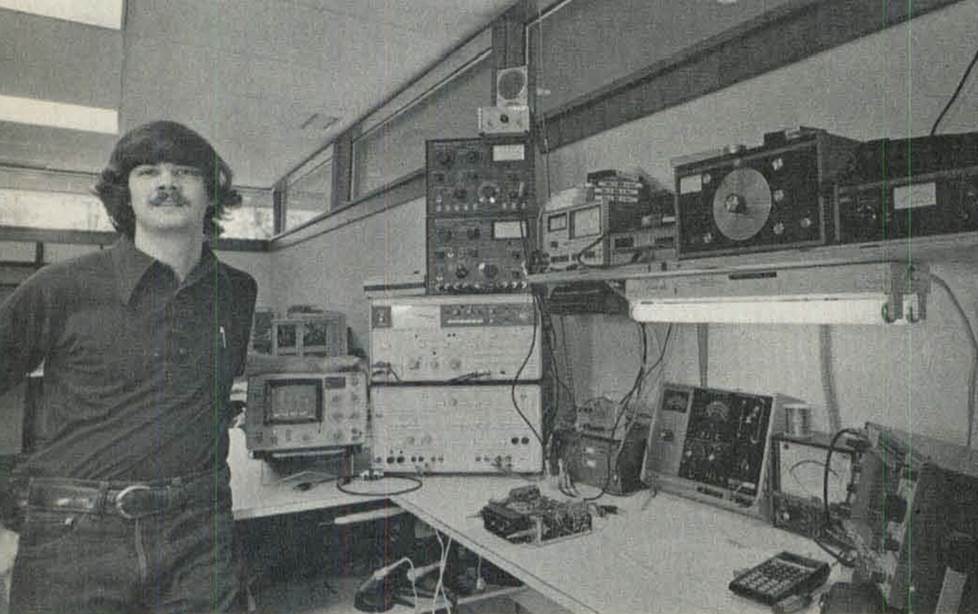
Rusty, one of our original techs in our testing lab (1979).
The 1970s end on a high note
The decade ended with my company being recognized as a rare 1970s startup. It was growing dramatically, and it had little debt and no outside investors. Our conservative financial management contributed to that. Because of the recognition of our success, I was invited to give a guest lecture at the University of Virginia’s prestigious graduate business school in 1979. I am still lecturing there today.
Chapter 2, coming soon
This concludes the first chapter of The Crutchfield Story. In Chapter 2, I will chronicle the decade of the 1980s. It was highlighted by some near-death situations, some remarkable successes, and our first color catalog. Chapter 2 will become available on April 1, 2024.




